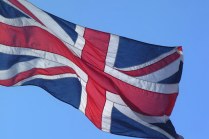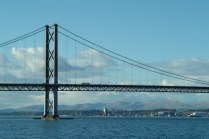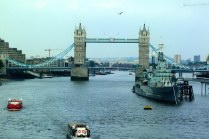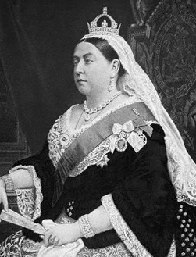The United Kingdom
Travel The World
The United kingdom of Great Britain and Northern Ireland, a kingdom consisting of Great Britain ( England, Scotland
and Wales) and Northern Ireland.
It includes all of the British Isles except for the area occupied by the Republic of Ireland, the Isle of Man and the Channel
Islands.Great Britain lies on the continental plateau of Europe.It's by far the largest island off the shores of the continent.
North Britain, or Scotland, falls into three natural divisions - the Highlands, the Central Lowlands and the Southern Uplands.
Wales on the west is a mountainous country. Northern Ireland is bounded on the north by the Atlantic Ocean, on the
northeast by the North Channel, on the southeast by the Irish Sea and on the south and west by the Republic of Ireland.



Images: Flying Union Jack, Forth Road Bridge in Scotland, Tower Bridge in London

History of Great Britain
But the two kingdoms quarreled many times. King William III wanted to unite them, but he died in 1702 before he could
carry out his plans. Parliament passed the act of Union in 1707, joining Scotland to England and Wales.The new kingdom
was called Great Britain. Anne agreed to the union, first as Queen of Scotland and then as Queen of England and Wales,
and the two kingdoms became one.
Wars with France
The French Revolution broke out in 1789. Great Britain went to war with France in 1793, because the French had taken
the area that is now Belgium and threatened to conquer other areas. After 13 months of peace in 1802 and 1803, war
broke out again. Admiral Lord Nelson won a great victory over the French fleet at Trafalgar, off the southern coast of
Spain, in 1805.
Great Britain and its allies, including Prussia and Russia, finally defeated the French on land in 1814 and sent Napoleon
escaped and started the war again. An allied army led by the Duke of Wellington defeated Napoleon at Waterloo, ending
the long series of wars. In Europe, Great Britain won the island of Malta from France. The British also won French
territories from the Cape Colony in South Africa to Ceylon, and islands in the Caribbean Sea.
London
London is the capital of Great Britain and on one of the largest and most interesting cities in the world. London has
a population of about 6 770 00. It lies on the River Thames, where the Romans landed nearly 200 years ago. From
about 1800 until World War Two, London was the biggest city in the world, but now there are many cities which are
much bigger.
London is interesting for many things. Tourists come from all over the world to visit its historic buildings, such as
St, Paulís Cathedral, which has a huge dome, and the Houses of Parliament, where you can see and hear the
famous clock, Big Ben.
They also come to visit its theatres, museums, and numerous shops, such as Harrods, Marks &Spenser where you
can buy everything. Like many big cities, London has problems with traffic and pollution. Although over 1 000 000
people a day use the London underground, there are still too many cars on the streets. The air isnít clean but itís
cleaner than it was 100 years ago.
Until the Clean Air Act in 1956, London was famous for its for or ďsmogĒ which is a mixture of smoke and for.
The best thing about London is the parks. There are five in the city centre. Parks of London are the places, where
Londoners and visitors can escape from the noise of the city streets and relax under the canopy of park.
A Quick Visitor's Guide to Scotland
Rolling hills, wilderness, forests, beautiful old market towns, picturesque islandsÖ thatís Scotland for you. You can
reach Scotland via air, by rail (from London), or by sea (ferry from Belgium).
Edinburgh: The capital and the largest city of Scotland, Edinburgh is probably best known for its castle. Not only
does it have a fascinating history, the castle provides breathtaking views in every direction.
Another must-see in Edinburgh is the Scotch Whisky Heritage Centre, which allows you to experience whisky sights,
sounds and smells, and lets you see firsthand how whiskey is made.
One more place to visit is the Writers Museum built in 1622. Itís dedicated to the lives and work of Scotland's great
literary figures, such as Robert Burns, Sir Walter Scott and Robert Louis Stevenson.
Other Edinburgh attractions include the National Library of Scotland, the Royal Museum the Edinburgh Dungeon, the
Real Mary Kingís Close, Ghost Tours, the Palace of Holyrood, Our Dynamic Earth, the Royal Yacht Britannia and the
Royal Botanic Gardens.
Glasgow: Glasgow is full of museums and art galleries renowned for their high quality displays. These are some of them:
The Burrell Collection, Fossil Grove, Gallery Of Modern Art, Glasgow Museums Resource Centre, Kelvingrove Art Gallery
and Museum Martyrs' School, McLellan Galleries, Museum Of Transport, People's Palace and Winter Gardens, Pollok
House, Provand's Lordship, Scotland Street School Museum, and St Mungo Museum Of Religious Life And Art
Shopping: Another feature of Glasgow that attracts the traveler is its shopping; it offers some of the finest shopping in
the UK.
The three main streets that you need to focus on are Sauchiehall St, Buchanan St and Argyll St. Besides these, you
can also look at Byres Rd in the west end, and Braehead shopping center.
Music: For the lover of live music, there are several great live music venues in Glasgow: The Glasgow Royal Concert
Hall, The Barrowlands Ballroom, King Tut's, The Garage, The SECC,the Clyde Auditorium and the Carling Academy
Glasgow among others.
Sports: If you are a sports fan, then you probably know that Glasgow is home to the two biggest football teams in
Europe: Rangers and Celtic FC. You can visit both grounds, Ibrox & Parkhead (Celtic Park). Besides these, you can
also visit Scotland's national football stadium, Hampden. Glasgow Rugby is another attraction for the lover of sports.
Fife: St Andrews, in the east of Fife, is the golf loverís arena. In order to play on the turf, visit the Old Course at
St Andrews, or the newly developed St Andrews Bay complex, among others.
Crail, the picturesque little harbor, is known as much for its delightful pottery, as it is for the crabs and lobsters that
can be bought in season. Also visit the Secret Bunker, the fishing villages, Anstruther and Pittenweem, the town with
a safe beach, Elie, Falkland, Dunfermline and Culross.
This quick guide should get you started on your adventure to the many-faceted and beautiful country that is Scotland.